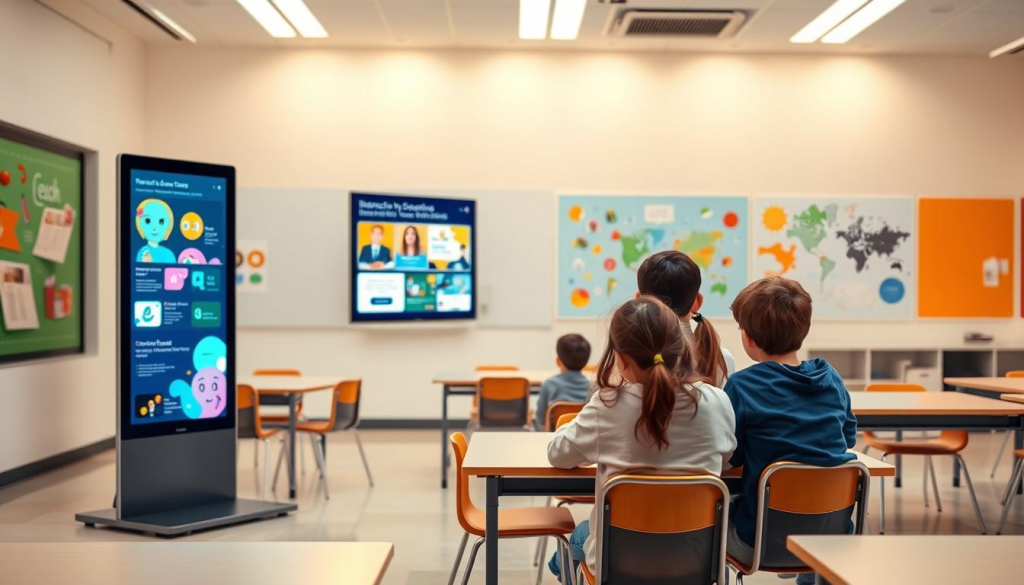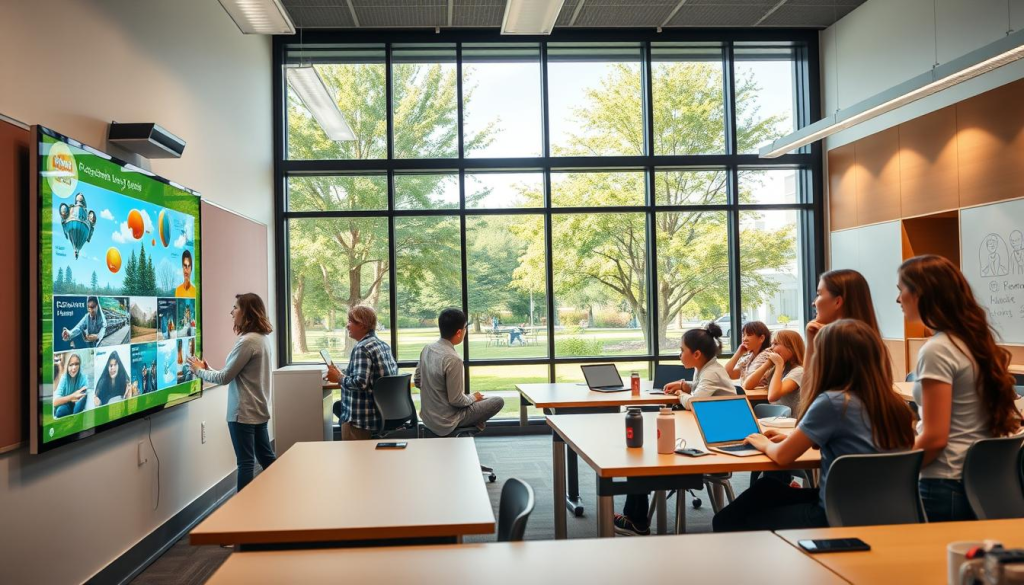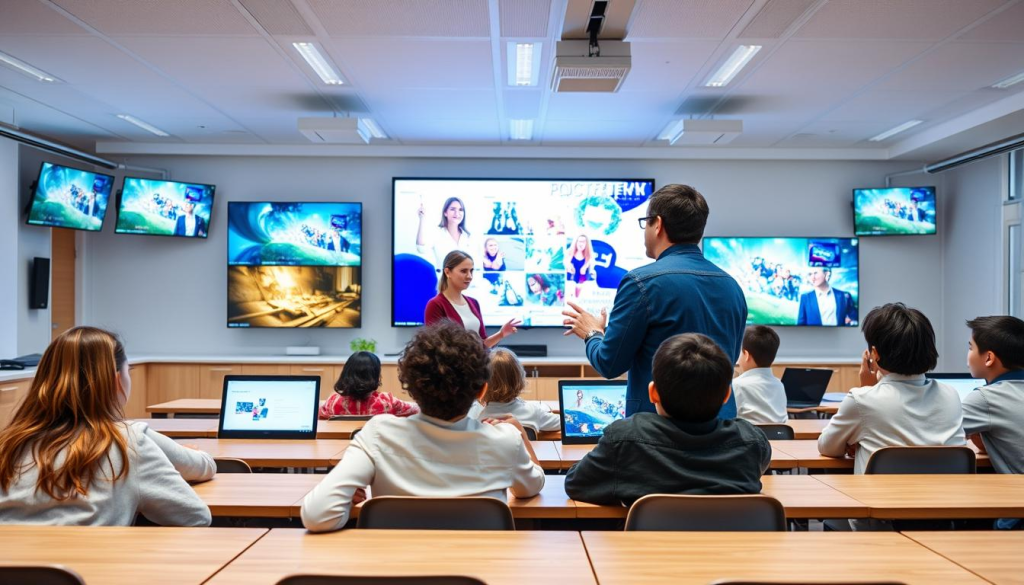In today’s fast-paced schools, digital signage education is changing the game. It’s replacing old static signs with new, dynamic ones. This shift makes communication better and learning more fun.
With digital signs, schools can share updates and schedules instantly. They also offer interactive content that grabs students’ attention. As more schools use these tools, they create a better learning environment.

Key Takeaways
- Digital signage enhances information recall rates among viewers.
- Students experience a boost in engagement through interactive digital displays.
- Educational institutions report improved community building via digital signage.
- Digital signage can significantly reduce navigation-related inquiries on campus.
- Real-time updates ensure that students get important info quickly.
The Growing Role of Digital Signage in Education
Digital signage has changed how schools and universities share information. It allows for quick updates, keeping everyone informed. Colleges use it for schedules and alerts, making communication better.
Interactive displays boost student engagement, with up to an 80% increase in participation. They adapt to different learning styles, improving retention by up to 60%. This shows digital signage’s value in education.
Switching to digital signage saves money on printing, with some schools cutting costs by 30%. This frees up funds for better resources or facilities.
Digital signage is key to campus safety. It quickly shares urgent messages, cutting communication time by 50%. This keeps everyone safe during emergencies.
Digital signage also makes operations more efficient. It reduces administrative work by about 35%. Plus, it can increase event attendance by 25%, showing its power in building community.
In summary, digital signage is becoming more important in education. It improves communication and engagement. Schools looking to modernize will find it offers many benefits.
Benefits of Digital Signage in Education
Digital signage has changed education, bringing many benefits. It helps schools communicate better and create a lively learning space. It makes learning more engaging and helps with school tasks.
Increasing Engagement Across Campus
Digital signage grabs students’ attention like never before. Studies show 96% of students notice it right away and remember what it says. Schools use it to promote events, celebrate students’ achievements, and build a lively campus culture.
Customization is a big plus. Digital signage can be tailored to fit students’ needs through various apps and integrations. Schools can also manage content from anywhere using cloud-based software. This makes it easier to handle school tasks.
Streamlining Administrative Tasks
Digital signage makes communication between school departments smooth. Schools can plan events for days, weeks, or even years ahead. This saves time and money by reducing the need for paper and ink.
Interactive features like touchscreens and QR codes encourage students to get involved. Digital signage is more than just sharing information. It helps students learn by creating content in marketing classes. It’s a step forward in how schools communicate with their communities.
Digital Signage Education: Enhancing Communication
Digital signage is changing how schools talk to students, teachers, and parents. It lets schools share updates and messages right away. This tech is better than old bulletin boards because it can show many messages at once and quickly change them.
Real-Time Updates and Custom Messaging
Digital signage is great for sharing news fast. Schools can post important stuff like safety alerts or schedule changes right away. This helps everyone stay on the same page.
Studies show schools with digital signage see a 30% boost in student interest during classes. It’s also good for safety, sending out emergency messages quickly.
Targeted Communication for Specific Audiences
Digital signage can talk to different groups like students, parents, and teachers. It can show off school events, celebrate student wins, and remind everyone about important days. This makes the school feel like a community.
Using digital signage can also cut down on tardiness. It helps students find their way around better, reducing navigation problems by 50%. This makes communication better and saves money on printing and posting.
| Statistic | Impact |
|---|---|
| Increase in student engagement during lessons | 30% |
| Reduction in navigation challenges | 50% |
| Decrease in student tardiness | 40% |
| Improvement in information retention | 35% |
| Preference for digital signage over traditional methods | 60% |
Interactive Digital Signage for Education
Interactive digital signage is changing how schools engage students and encourage teamwork. It uses technology to make learning spaces both attractive and interactive. With multimedia tools, teachers can make lessons more engaging and effective.
Creating Engaging Learning Environments
Interactive digital signage is making learning environments more engaging. Schools using this technology see students getting more involved. For example, digital signs grab the attention of tech-savvy students better than old bulletin boards.
This visual appeal boosts learning results and helps the environment by reducing paper use.
Facilitating Collaborative Learning Experiences
Interactive digital signage supports teamwork in learning. It offers features like real-time updates and automated content, creating a great team environment. QR codes and touch screens let students learn on their own, exploring topics they’re interested in.
In emergencies, it quickly shares important information. This keeps everyone safe and informed.
Digital Signage Solutions for Educational Institutions
Digital signage solutions are key for schools to improve communication and make processes smoother. Schools use software and hardware made just for them. Knowing about digital signage software and how to pick the right hardware can really help.
Types of Digital Signage Software
There are many digital signage software options out there. Screenly is one that’s easy to use and lets teachers and admins manage content from anywhere. It has scheduling tools to help manage displays better.
Users can make playlists with images, videos, and animations for different times. This is useful for showing things like cafeteria menus or student achievements.
Choosing the Right Hardware for Schools
Choosing the right hardware is important for a good digital signage experience. Screenly offers a Player for every screen, which you can buy online. For those on a tight budget, Screenly OSE is a free option with some limitations.
It’s a good choice for schools moving away from printed materials. Features like multi-use displays are great for updates, from menus to emergency alerts.
| Features | Screenly Software | Screenly OSE |
|---|---|---|
| Content Management | Advanced scheduling and remote management | Limited scheduling features |
| Cost | Low-cost subscription | Free option available |
| Support | 24/5 support available | Community support only |
| Device Compatibility | 150+ devices | Compatible with specific configurations |
Integrating Digital Signage in Education
Digital signage is becoming a key part of education. Schools are using it to improve teaching and learning. They plan carefully to make sure it works well with old ways of sharing information.
Setting it up means training staff and helping them use it. For example, the University of Colorado-Boulder uses digital signage to help students work together. It shows when rooms are free and for events, helping students join in.
Digital signage makes talking to students and staff easier. Schools can pick from many apps to meet their needs. It helps show school spirit, like during pep rallies. Studies show it can make students more involved, sometimes by up to 60%.
It also helps with school tasks. It can send out updates and alerts quickly. This keeps everyone safe and informed. Plus, it cuts down on paper use, saving money and being better for the planet.
In short, digital signage makes learning better, gets students involved, and shows schools are open to new ideas.

Digital Sign Boards for Universities
Universities are now using digital sign boards to better communicate with students and staff. These tools help share important information across campus. They are key in improving communication, promoting events, and making campus life more efficient.
Case Studies of Successful Implementations
St. Charles Community College and California State University, Fullerton, have seen great success with digital sign boards. At St. Charles, outdoor signs reach thousands of people every day. They help spread the word about enrollment and campus events.
At California State University, Fullerton, digital signs keep students informed about events and emergencies. This ensures everyone on campus is up to date.
The Visix system is known for its reliability and versatility. It supports multiple user accounts and integrates with apps like 25Live and Google Calendar. Using digital signs has also cut down on paper usage by 10 to 15 percent, helping the environment.
Best Practices for Campus-Wide Deployment
When setting up digital signage, it’s important to make it easy to use. Staff should be able to manage the systems with minimal training. This ensures everyone can use them effectively.
Having clear communication plans is also key. They should include emergency notifications on all screens. This way, everyone can respond quickly in urgent situations. Digital sign boards also allow information to be shared on PCs and mobile devices, making them essential for today’s universities.
Maximizing the Benefits of Digital Signage Content for Classrooms
Schools can greatly improve learning by using digital signage content. By adding educational videos, infographics, and student projects, teachers can make content fit specific lessons. This method keeps students interested and encourages creativity in the classroom.
Digital signage keeps information up-to-date in all classrooms. LG’s solutions work well for 18/7 to 24/7, making sure important messages are always available. This makes managing content easier and keeps students informed and active.
Interactive features make digital signage even more effective. LG’s interactive whiteboards and UHD displays help personalize learning. When students help create content, they become more connected to what they’re learning.
Switching to digital signage also saves money. Schools can cut print costs by up to 50%. This extra money can be used for more educational resources, making learning even better.

Conclusion
Digital signage is changing how schools talk to each other and to students. It makes sharing news and schedules easy for everyone. Schools are saving money by using digital signs instead of paper.
These signs also help in emergencies by sharing updates fast. This keeps everyone safe and informed. Plus, they grab attention better than old signs, helping students learn more.
Looking to the future, digital signage will help schools grow and work better together. It makes learning more fun and helps everyone understand each other. Digital signs will play a big role in shaping education for years to come.
FAQ
What are the primary benefits of digital signage in education?
Digital signage boosts student engagement and communication. It also makes administrative tasks easier. It offers real-time updates and promotes school spirit. Plus, it creates dynamic learning spaces.
How does interactive digital signage enhance learning environments?
Interactive digital signage uses multimedia to engage students. It makes complex ideas easier to grasp. This method helps students remember information better than traditional teaching.
What types of content can be displayed using digital signage?
Digital signage can show many things. This includes class schedules, student achievements, and event announcements. It also displays infographics, educational videos, and safety alerts in real-time.
Why is real-time communication important in educational settings?
Real-time communication through digital signage keeps everyone informed. It handles updates like schedule changes or emergencies. This reduces confusion and boosts safety.
What features should I look for in digital signage software for schools?
When choosing digital signage software, look for ease of use. It should have simple content management and scheduling. Also, it should offer analytics and support interactive formats for better engagement.
How can educational institutions successfully integrate digital signage?
Successful integration starts with assessing your current setup. Then, plan strategically and train staff. Provide ongoing support to ensure digital signage meets educational goals.
Can you provide examples of successful digital signage implementations in universities?
Yes, the University of Colorado-Boulder is a great example. They use digital signage for room scheduling. This boosts student engagement and improves efficiency with interactive boards.
What are some best practices for deploying digital signage across a campus?
Best practices include involving stakeholders in planning. Regularly update content to keep it fresh. Make sure the signage supports your educational goals for the best results.
How can schools maximize digital signage content in classrooms?
Schools can make learning diverse and engaging. Use various media formats that match lesson goals. Involve students in creating content and update displays often to keep interest high.